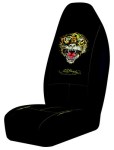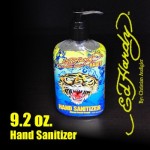The Ed Hardy Paradox
Ed Hardy is a tattoo icon. He trained under one of the progenitors of modern American tattoo, Sailor Jerry. He studied under the Japanese tattooist Horihide, becoming one of, if not the first American artist to penetrate the secretive, sometimes sordid and always enchanting world of Japanese tattoo. In combining his old school training under Sailor Jerry with the training he received from Horihide, his use of bold colors, subtle shading and elaborate subject matter began the transformation of tattoo into its modern incarnation.
Unfortunately, for the overwhelming majority of the public, almost certainly including a huge subsection of the tattooed population, Ed Hardy is the name of a gaudy, offensively overpriced brand of clothing and various other novelties, knick knacks and chachkas. At this point, there is virtually no limit to the panoply of products graced by the name “Ed Hardy.” Perfume, hand sanitizer, cell phone covers, automobile seat covers and even a remote control speed boat bear the brand. The entire cultural paradigm that has arisen around Ed Hardy’s brand is rife with sad irony. If you’re paying attention, it is simply impossible to ignore the bizarre opposing tension between the fact that by lending his name to a commercial brand based on his work, he has, to some extent, obscured the work itself.
Just to be clear, it is not my intent, in any way, to sit in judgment of Ed Hardy for his decision to take advantage of an extremely lucrative business opportunity. Even if he recognizes the aforementioned irony, I would be shocked if he finds it sad; more likely he’s smiling his way all the way to the bank.
Oddly, I don’t really find much irony in Hardy’s decision to license his name and art, but rather I find it in the culture it has engendered. There is nothing ironic about an artist’s desire to make a living from his art and I would find offensive any assertion that Ed Hardy is a “sellout” or any similar claim. After all, Andy Warhol’s art was specifically designed alternately as a celebration and at times criticism of popular culture, but always doubtless a money making endeavor. That path led him to be lauded as one of the great artists of the 20th century and perhaps of all time. Indeed, efforts to elevate art as something holier than commerce, especially in western culture is farcical at best and overtly pretentious at worst. Certainly art for art’s sake is praiseworthy, but at the same time, wealthy patrons have been integrally involved in the art community for centuries.
Instead, I find irony in the fallout that has ensued from monetizing the Ed Hardy name. I find it in the market segment in which his clothing has been marketed and by extension, in the customer base that it has attracted. If the practice of tattoo is literally a physical incarnation of the counterculture then Ed Hardy was and is a booming voice of that counterculture. Contrary to that, the Ed Hardy brand could not be less representative of the counter culture; it has become the voice of the mainstream, the voice of celebrity, the voice of unrepentant materialism, and the voice of image driven social climbing. The brand is a tangible tautology. Certainly one can debate to the merits of the brand from a stylistic perspective (I think by now you can tell where I land in that debate), but there is no deying that to some extent a $200 Ed Hardy Shirt has become worth $200 simply because it costs $200. It is a living, breathing social experiment, evincing the notion that exclusivity due to a prohibitively expensive price point has become valid end in itself. The mere fact that only a small subset of people can afford and are willing to spend that kind of money on a T-shirt, is not only a validation of the price, but an inducement to desire it. The cult of celebrity latched onto this absurdity early and the seething masses, yearning for notoriety, fame and acceptance in the cult of cool followed eagerly.
Hours of pain, discipline and ultimately the reward of a beautiful, unique piece of art as well as relief from the chair and machine have given way to rhinestone logos, excessively gelled hairdoes, mirrored wrap around sunglasses indoors, spray on tanner, pencil thin chin strap beard and mustache combinations and in many cases steroid addled bodies. What was once earned literally through blood and sweat and disdained cool is now purchased at the mall for the promise of cool. Even those “Hardy gear” consumers that are tattooed themselves likely do not have an appreciation for the art. Most (not all) of them are cultivating an image in which the tattoo is a means to an end, not an end in itself. Hopefully, when those people look at their tattoo 20 years from now, when they have graduated to the next Ed Hardy, or FUBU or whatever, they’ll see an empty doodle instead of a masterpiece and that lack of emotional of connection will reveal in shocking fashion what Ed Hardy the artist and more broadly tattoo in general is really about.
Of course these are just my opinions. Maybe I have no idea what I am talking about. Maybe MiamiInk, LAInk, the Ed Hardy brand and all other attempts by corporate culture to cash in on the tattoo boom isn’t a fad and maybe it is a sign that tattoo is in the mainstream to stay. If that’s the case, and the day comes that tattoos are purchased at a doctor’s office under anesthesia or god forbid, the mall, using a template and some sort of automatic tattoo machine, I’ll be sad for a moment at what has become of tattoo, but then I’ll smile and be glad that I know what it means to earn it; to sit in a chair for 4, 6-hour sessions to complete a 1/2 sleeve and to know that my tattoos have nothing to do with who I am trying to be and everything to do with who I already am.



